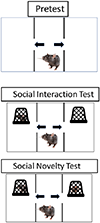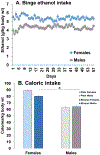Conditioned social preference and reward value of activating oxytocin-receptor-expressing ventral tegmental area neurons following repeated daily binge ethanol intake
- PMID: 34964139
- PMCID: PMC8858886
- DOI: 10.1111/acer.14769
Conditioned social preference and reward value of activating oxytocin-receptor-expressing ventral tegmental area neurons following repeated daily binge ethanol intake
Abstract
Background: Individuals with alcohol use disorder (AUD) exhibit a disruption of social behavior and dysregulation of oxytocin signaling in the brain, possibly reflecting decreased activation of oxytocin receptors (OxTRs) in reward pathways in response to social stimuli. We hypothesize that daily binge ethanol intake causes a deficit in social reward and oxytocin signaling in the ventral tegmental area (VTA).
Methods: After 9 weeks of daily binge ethanol intake (blood ethanol concentration >80 mg%), OxTR-cre mice underwent conditioned place preference for social reward. Separate groups of mice were tested for the effects of binge ethanol on voluntary social interactions, food reward, locomotion, and anxiety-like behaviors. A subset of mice underwent transfection of OxTR-expressing VTA neurons (VTAOxtr ) with a light-sensitive opsin, followed by operant training to respond to light delivered to VTA.
Results: Ethanol-naïve male mice increased the time spent on the side previously paired with novel mice while ethanol-treated mice did not. Binge ethanol did not affect conditioned place preference for food reward in males, but this response was weakened in ethanol-treated females. Ethanol treatment also caused a sex-specific impairment of voluntary social interactions with novel mice. There were minimal differences between groups in measures of anxiety and locomotion. Ethanol-naïve mice had significantly greater operant responding for activation of VTAOxtr than sham-transfected mice but ethanol-treated mice did not. There was no difference in the number of VTAOxtr after binge ethanol.
Conclusions: Daily binge ethanol causes social reward deficits that cannot be explained by nonspecific effects on other behaviors, at least in males. Only ethanol-naïve mice exhibited positive reinforcement caused by activation of VTAOxtr while daily binge ethanol did not alter the number of VTAOxtr in either males or females. Thus, subtle dysregulation of VTAOxtr function may be related to the social reward deficits caused by daily binge ethanol.
Keywords: binge ethanol; oxytocin receptor; social reward; ventral tegmental area.
© 2022 by the Research Society on Alcoholism.
Figures











References
-
- Caspers KM, Cadoret RJ, Langbehn D, Yucuis R, Troutman B. Contributions of attachment style and perceived social support to lifetime use of illicit substances. Addict Behav. 2005; 30:1007–11. - PubMed
-
- Ferguson JN, Young LJ, Hearn EF, Matzuk MM, Insel TR, Winslow JT. Social amnesia in mice lacking the oxytocin gene. Nature Genetics 2000; 25: 284–288. - PubMed
Publication types
MeSH terms
Substances
Grants and funding
LinkOut - more resources
Full Text Sources
Molecular Biology Databases

